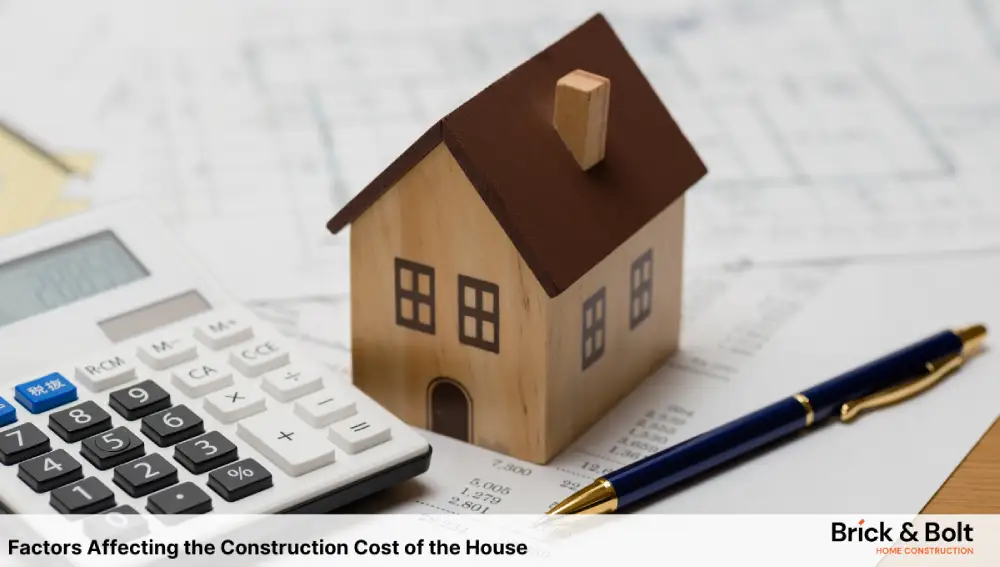Construction is an expensive endeavour, and anyone looking to calculate the house construction cost needs to be aware of the difficulties involved in the process. Generally, several factors affect the construction cost of the building, including the building’s size to the building’s registration and approval costs, which substantially impact the entire budget of the construction. Hence, we bring the 11 most important factors that influence construction cost.
Factors Affecting the Construction Cost of the House

The following are the major house construction cost factors:
- Size of a House
- Physical Condition of a Construction Site
- Location of Site
- Complexity of Design
- Material Cost
- Labour Cost
- Client’s Requirements
- Method of Construction
- Delay in Construction
- Registration and Approval Cost
- Market Fluctuation
Let’s dive deeper into all the factors
1. Size of a House
One of the most common factors that affect construction cost is its size. The project size considerably impacts the labour and materials requirements, which affects the construction cost. Obviously, if you are constructing a 1000 sq. ft. house, due to differences in construction costs, it costs less than building a 2000 sq. ft. house.
2. Physical Condition of a Construction Site
The site’s physical condition is one of the most influential cost factors for home construction. Conditions like ground blockage, adjoining and existing structures, and aboveground and underground utilities impact the building’s design and construction.
In simple terms, site conditions such as poor soil, uneven terrain, the existence of underground pipes, water bodies, and environmentally hazardous areas on the project site could significantly raise project costs. Because if there are any unfavourable conditions, you need to do extra labour works like site clearance, demolition, and remediation, making building on them more expensive.
3. Location of Site
Location plays an important role in costing. One of the most simple phenomena is that high-value locations demand high-value construction. Apart from that, if your site is located at an inconvenient location, like at a high altitude, flood-prone area, or rocky area, it makes your construction project difficult, and you require additional labour and resources, resulting in a cost rise.
The availability of resources and capacity of existing services also impact the cost. Because if these services are far away from the site location, connecting to them might be expensive.
4. Complexity of Design
The building’s geometrical design, including its shape, size and complexity, also influences house construction cost factors. costs. For example, a large built-up area with a standard rectangular shape, average elevation and simple floor plans tends to be less expensive than a small built-up area with curved or complex-shaped buildings.
Moreover, buildings with unique features might need pricey materials, leading to a rise in cost. The client’s perspective on sustainability and total life cycle expenses can also influence the project’s final cost.
5. Material Cost
Your priorities and choices of materials can also impact the cost because numerous alternatives are in the market for materials which you can use for various housing components. If you purchase costly items, your construction material rate will be increased.
The construction material costs include the costs of raw materials, shipping, and taxes. However, depending on the project’s location and size, the cost of each of these three elements may change. For example, if your site location is far from the available resources, you must spend extra shipping and labour for logistics. Similarly, if your project size is bigger, you require more raw materials and vice versa.
6. Labour Cost
The labour costs vary state by state. Furthermore, in certain areas, labour wages are charged on an hourly basis, whereas in others, they are charged on a daily basis. As a result, it is critical to understand labour standards and estimate building costs properly. But, due to the supply-demand concept, you may have to pay more for labour if there is a large demand for it.
7. Client’s Requirement
Fulfilling a customer’s requirements is at the forefront of any building project. Client’s requirements might change substantially; for example, what is important to one client might be irrelevant to another. But, their needs mostly revolve around aesthetics, durability, on-time completion, warranty support and overall user appeals. Some of these factors can be addressed during the design process, while others depend on the contractor’s on-site implementation. It is critical to design and build a building in accordance with the needs of the client. However, over-specifying a building and using high-quality materials and craftsmanship will raise the final cost.
8. Methods of Construction
You can determine the final cost of a project by how much your contractor costs for completing the construction job. It depends on the overall cost of materials and labourers, operation plant cost, subcontractors’ competitiveness, and the cost of executing the individual site. The contractor also adds contingency costs and a profit margin to these prices.
9. Delays in Construction
Delay in construction is also one of the significant factors affecting the construction cost. Because it causes unexpected issues like a rise in equipment rents, storage cost of raw materials, rise in wages of labourers and contractors, etc., that can significantly impact the final construction cost.
10. Registration and Approval Cost
According to your location, your governing authority charges for registration, approval and permits. All these costs vary by each authority. Each authority may have its own rate for such fees. So, it’s crucial to add the approval and permit costs to the end budget along with the other expenses.
11. Market Fluctuation
Market fluctuation is another factor that influences the construction cost. It arises as a result of changes in the supply and demand of resources like construction materials, labourers, equipment rents, etc. Price hikes on these elements can also lead to delays in construction and significantly impact the overall cost of building a house.
Conclusion
On a final note, understanding the various cost factors for home construction is critical for determining a realistic budget and ensuring the project’s success. You must consider these elements during the design and execution of your construction projects.
In addition, you can use the online house construction cost calculator to get a basic estimate for your construction cost. However, it’s crucial to have a well-thought-out construction design before you start estimating the final construction cost of the house. For that, you can visit an experienced architect or reputed construction company like Brick&Bolt to get full guidance or design for your dream house; it will aid in determining the most accurate estimation for your proposed project.

